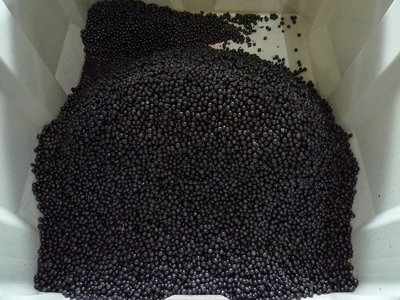Image exploitation used to improve wine quality
Grapes can be graded for quality and be checked for foreign object contamination simultaneously using a new system under development in Germany.
A novel piece of optical sorting equipment is set to help make the most out of grapes’ quality. Researchers from the Fraunhofer Institute for Optronics, System Technologies and Image Exploitation IOSB in Karlsruhe are working to develop the equipment together with Armbruster Kelterei-Technologie GmbH, Ingenieurbüro Waidelich and Geisenheim University in the GrapeSort project, which is funded by Germany’s Federal Ministry of Economics and Technology (BMWi).
Several tons of grapes pass through the sorting facility every hour. Grapes of the Trollinger, Riesling, Weißburgunder and Lemberger varieties have been successfully sorted in preliminary testing, with project partners unanimously declaring the results of the sorting to be good.
Sorting the good grapes from the bad and the miscellanea
Once the vats of grapes have been delivered, their contents pass through a feeding unit into the destemmer provided by Armbruster, which separates the berries from their stems.
Next, the grapes are individually placed on a conveyor belt by a newly developed conveying system. “What’s important is to get the berries onto the belt without damaging them,” says Dr Kai-Uwe Vieth, a scientist at the IOSB.
The grapes are then carried along by the conveyor belt past the IOSB’s sorting module at a speed of 3 m/s. At the heart of the module is a high-speed line scan camera that records the material flow, taking photos of the fruit as it rushes past - 18,000 times a second. IOSB analysis software evaluates each image in milliseconds and controls compressed air jets that blow foreign objects such as insects, vine shoots, stones or twigs out of the material flow. Bad or undesirable berries are also removed by the Waidelich air ejection unit.
The ‘good’ grapes fall into a container.

Image: © Fraunhofer IOSB
“Our sorting module is designed to exceed the capabilities of current machines. Not only does it remove foreign objects, it also sorts the berries into various quality grades. That lets you create exactly the wine you want,” says Vieth.
The camera is trained in advance what to deem ‘bad’. Mould, earwigs, leaves and the wrong degree of ripeness are typical rejection criteria. Sorting is done based on analyses of shape and colour.
The researchers are already able to use their equipment to recognise various degrees of berry ripeness based on nuances of colour. In future, they also want to be able to tell the ripeness by investigating how much sugar there is in the fruit.
“Winemakers measure sugar content using a refractometer, which allows them to read out on a scale the degree to which sugar molecules in the must influence the angle of refraction of incoming light. The higher the sugar content, the more the light is refracted. The line scan camera can also measure reflected light, as it is a light-sensitive line,” Vieth explains. This integrated line sensor is sensitive to both visible and invisible light. For the laboratory analyses that run while the measurements are taken, Vieth and his colleagues use imaging sensors for the wavelength range of 240 to 2500 nm. The sensors generate spectra for each pixel.
An optimised functioning prototype that will serve as a basis for a production-ready facility is set to be tested for the first time in October 2013. All the components undergoing constant development and optimisation - the feeding unit, the camera box and the air ejection unit - will be connected up and tested in time for the grape harvest. And the entire project will be put to the sensory test at another premiere in June 2014: the tasting of the resulting wine by the Geisenheim University viticulture experts who are providing their expertise to the project.
Vieth and his project partners are convinced that their wines will be a great success: “The sorting system helps to improve quality and separate the harvest into various quality levels. This will allow winemakers to expand their premium output.”
In-house ginger processing for beverage maker
A ginger beer manufacturer reduces its supply risk by investing in pack-house technology to...
Tailor-made solutions for sliced meat on show at IFFA
At this year's IFFA in Frankfurt, the MULTIVAC Group will be showing its latest line...
Five ways emerging tech can help food and beverage manufacturers
As food manufacturers embrace new innovations, they must also navigate the complex landscape of...














